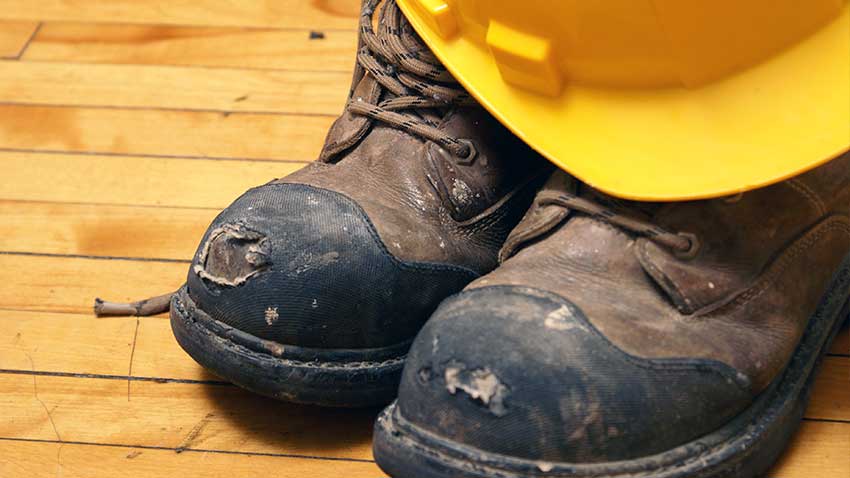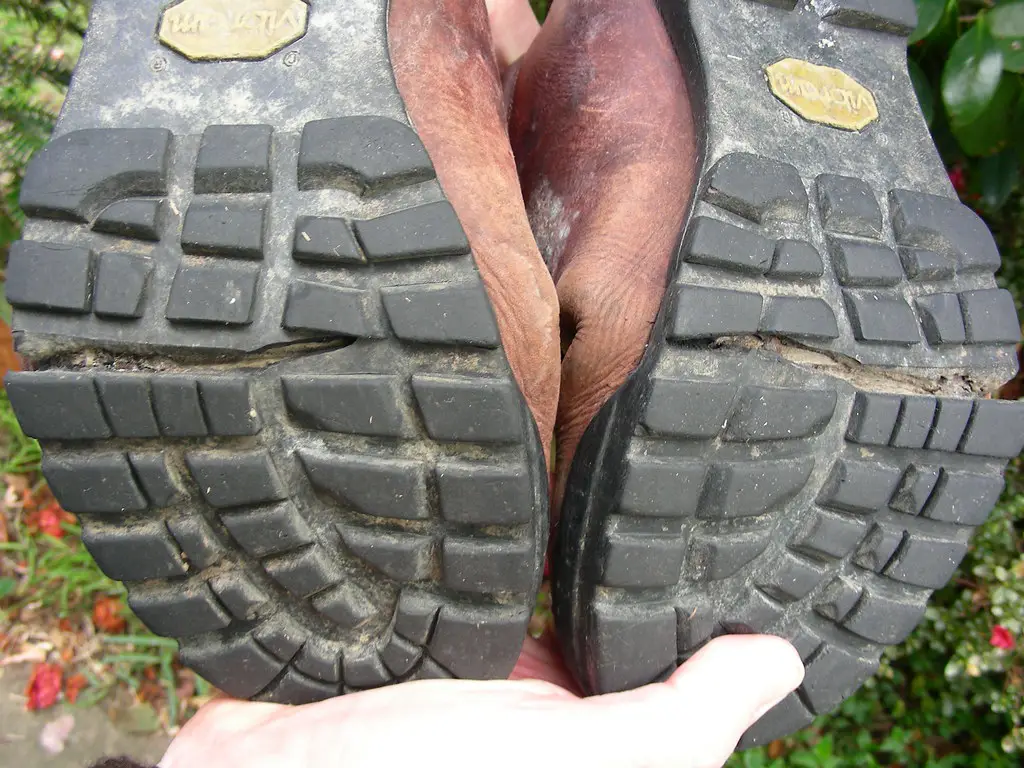Steel toe boots are a part of protective footwear that workers who work in hazardous work environments are required to wear as part of their mandatory PPE clothing.
These types of boots provide maximum protection to a worker where there are high risks of foot injuries.
And as the name suggests the toe cap is made of steel that can prevent your foot from getting crushed if a heavy object falls or rolls on it.
However, how long do steel toe boots last – you ask?
In my experience and the knowledge I have gathered, a good pair of steel-toe boots can last you anywhere between 6 to 24 months or 2 years. They do tend to wear out faster than other kinds of safety work boots considering the daily beating and trashing it undergoes.

Having said that, several other factors play a vital role in determining the duration or lifespan of steel toe boots. Read on to learn more about steel toe boots.
Look for these signs to know if your steel toe boots are dying
Every item you own will have an expiration date, which is the normal way of life. They will start showing signs of deterioration with time which will again depend on how often you use those things.
Similarly, for your steel toe boots as well, there are a few very particular signs that you should look out for to understand that it is time for you to replace them or get rid of them.
It is wise to do this so that you don’t become a victim of some serious foot injury for not wearing a good pair of safety toe boots.
1.) The steel toe cap
Checking the steel toe cap is one of the first things you should do because the protective toe cap is the most important thing of a safety boot.
If they have worn out then there will be a prominent dent that you would notice, which only means that they can no longer provide you with the foot protection you need.
The possible dent could have occurred after something heavy fell on it, so do make it a point to check your boots after such an occurrence to be more certain.
2.) The steel is visible
If you can see the steel toe cap through the leather of your boots then it is time to change them with a new pair.
It is a sign of wear and tear, which should not be neglected as they will fail to serve their basic function of protecting your toes in the case of any mishap.
3.) Metatarsal guard
Most steel toe boots come with a metatarsal guard on top of the boots, which can also get dented after an object falls on the boots.
There are chances of the guard poking right through the boots. Both these are signs of changing your safety boots.
4.) Outsoles damage
Since your outsoles take a lot of physical brunts as you walk around throughout the day in your boots, there is a chance they will wear out rather faster than any other part of your boot.

The outsoles are exposed to all kinds of surfaces which can lead to them losing traction and in turn the ability to protect you from slipping fails.
There could also be holes which can further lead to more problems. If there are any such signs then your boots have done their time.
See also: How to Fix a Hole in a Rubber Boot? (Step By Step Guide)
5.) Insoles damage
Sometimes due to regular or daily use of the boots the insoles can also lose their functionality by falling apart. If they become too flat that means they will no longer provide the support or comfort you are used to from your steel toe boots.
6.) Midsole damage
The midsole which falls in between the outsole and insole provides you with an adequate amount of cushioning. Many times due to prolonged and regular usage of the boots, the midsole can start wearing off too.
They can become shriveled, less cushiony, unable to absorb shocks, and reduce the height of your boot. All these are signs of a damaged midsole.
In this case, you again need to make sure you are not compromising on your feet protection by continuing to wear them. It is time to change the boots.
7.) Leakage
If water or any form of liquid is seeping into your boots, you would know that there is a leakage in your boots somewhere and that it has lost its waterproof or water-resistant feature.
It could be that the seams have gotten weak over time. This means your socks getting wet, and being in those wet socks all day until you get home in the evening.
Being in wet socks is not only uncomfortable and unpleasant, but it can also lead to further health issues. So make sure to check for these signs and change your boots when it is time.
8.) Punctures
In certain cases, your steel toe boots could have holes from being punctured by sharp items. This can damage the protective nature of your boots.
In such a situation again instead of getting them fixed by a cobbler, you should consider changing them with a new pair of boots altogether. The reason is, a cobbler can only do a temporary fix, not a permanent one.
9.) Too flexible
Steel toe boots are often known to be slightly rigid compared to other safety work boots. This is mainly due to their protective features and the fact that steel toe boots are mostly worn by people who do heavy-duty jobs.
However, if your boots seem too flexible over some time, then you should understand that they are slowly coming to an end and need to be replaced as soon as possible. This can easily lead to muscle strains and sprains due to the lack of support.
10.) No more support and comfort
Although steel toe boots are not entirely popular for adding to your comfort level, they provide you with the basic comfort and support feature that any type of safety footwear is supposed to provide.
This can lead to severe body pain, knee pain, joint pain, ankle pain, etc, which is not a good sign. Hence, make it a point to add this to the list of boots that have worn out.
This list of signs to identify a damaged or worn-out pair of steel toe boots may seem overwhelming at first, but once you pay close attention to your boots, you will come to realize that these signs can go easily unnoticed by you.
Factors that can determine how long your steel toe boots will last
There are various factors and things that play a role in determining the lifespan of your steel toe boots.
1.) The quality of the boots matters a lot. If you buy from a well-trusted brand, you are sure to get a reliable pair and value for the money you spend on them. Good brands will always use premium material and add good features to the boots.
2.) The boots should be made from good quality materials and have a high-end construction in the make.
3.) The kind of surface you walk on with your boots daily does matter as this will determine how strong the soles are.
4.) If you cover a lot of distance with the same pair of boots, then its lifespan will simply get shorter due to a lot of usages.
5.) If you wear your boots to work regularly then it is natural for the boots to wear out over time.
6.) It matter how well your boots fit your feet.
7.) If you wear the same pair of boots daily instead of switching them with an extra pair of similar boots then they are sure to wear out faster.
8.) If your boots come in contact with sharp objects or edges then they will get damaged faster.
9.) When your boots are exposed to different weather conditions like rain, heat, and cold temperatures, it will affect the condition of your boots to a great extent.
10.) If your boots are exposed to harsh elements like dirt, grime, and harmful chemicals, then it will ruin them faster than expected.
Things you should do to make your steel toe boots last longer
If there are factors that play a role in damaging your steel toe boots faster than you would like, there are also ways to make them last longer.
So let’s take a look at some of these helpful tips.
1.) Wash or clean your boots every time they get dirty with a soft-bristled brush and some mild soapy water. Leaving them uncleaned will lead to them rotting quickly due to all the dirt and grime stuck on them.
2.) Dry your wet boots out in a well-ventilated area to get rid of any moisture and avoid fungus from growing in them.
3.) It is a good idea to waterproof your boots right after buying them. This helps in keeping them young and increases their durability.
4.) Untie your boots carefully and properly after each wear instead of pulling them off directly, which causes them more harm than you would realize.
5.) Try and limit wearing your work boots only to work and not as a casual pair when going out with friends or family. This will reduce their usage, which in turn will give your boots some time to rest.
6.) Keep switching between two different pairs of work boots if possible, to not overwear just one pair regularly.
7.) Replace the insoles of your work boots whenever you feel the need to do so, instead of avoiding them altogether.
8.) Give your boots to a cobbler for resoling, if the soles are starting to wear off, to avoid them from completely falling apart.
9.) Always keep or store your work boots in a well-ventilated area of your house.
10.) Make it a point to wear good quality moisture-wicking socks with your work boots.
11.) Do not overwear your boots more than they can handle.
Wrapping up
It is important to take good care of your work boots if you want them to last you for a longer period. As long as you are careful and treat them with the utmost care they can surprise you how much beating they are capable of enduring.
Protective footwear is an important part of a person’s workwear but you should not expect any miracles out of them, they will serve you well depending on how well you look after them. However, eventually, you will have to your old pair with a new one for your safety.







